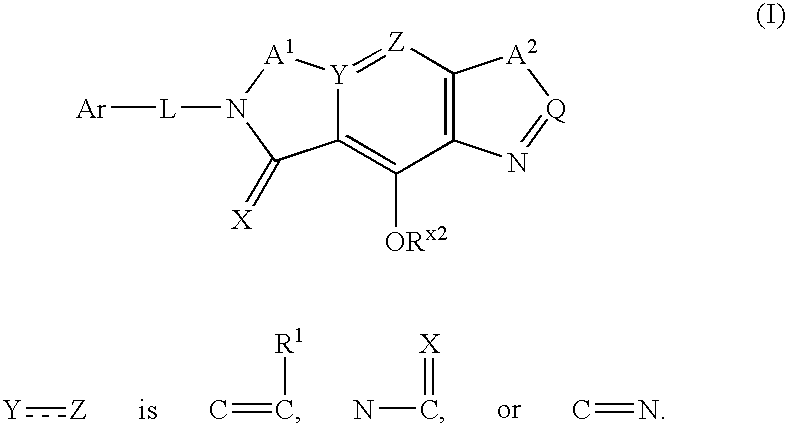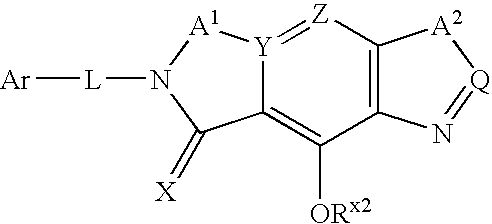Pre-organized tricyclic integrase inhibitor compounds
- Summary
- Abstract
- Description
- Claims
- Application Information
AI Technical Summary
Benefits of technology
Problems solved by technology
Method used
Image
Examples
example 1
N-4-fluorobenzyl-succinimide 1
[0400]
[0401] Freshly ground potassium carbonate, K2CO3 (31 g, 225 mmol) was added to dry acetone (200 ml) in a 3-necked flask equipped with drying tube, condenser, and mechanical stirrer. Succinimide (7.43 g, 75 mmol) and 4-fluorobenzylbromide (11.21 mL, 90 mmol) were added. The mixture was refluxed for 19 hours and filtered through Celite. Acetone was removed under vacuum, diluted with EtOAc, washed with saturated aqueous sodium bicarbonate and also with brine, dried (MgSO4), filtered and concentrated to give crude. Crude product was chromatographed (EtOAc / Hexane) on silica gel to give N-4-fluorobenzyl-succinimide 1 as white solid (15.22 g, 85%). 1H NMR (CDCl3) δ 7.4 (dd, 2H), 7.0 (t, 2H), 4.6 (s, 1H), 2.7 (s, 4H).
example 2
5,8-Dihydroxy-[6,7]-N-(4-fluorobenzyl)-succinimido-quinoline 2
[0402]
[0403] N-4-fluorobenzyl-succinimide 1 (8 g, 38.6 mmol) and 2,3-pyridine carboxylic acid dimethyl ester (7.9 g, 40.6 mmol) were dissolved in dry tetrahydrofuran (THF, 78 mL) and dry methanol (MeOH, 1.17 mL) in a 3-necked flask with mechanical stirrer and condenser. Sodium hydride (NaH, 60% in mineral oil, 3.4 g, 85 mmol) was added slowly in four portions. The mixture was stirred until bubbling ceased, then refluxed for 24 hours. HCl (30 mL 6 M) was then added to the mixture while in an ice bath, with stirring for 15 minutes. Diethylether (100 mL) was added. The precipitate was filtered, washed with diethylether and H2O, and dried under vacuum at 100° C. Crude product was then recrystallized from 1 L refluxing dioxane and dried under vacuum at 100° C. to give solid 5,8-Dihydroxy-[6,7]-N-(4-fluorobenzyl)-succinimido-quinoline 2 (8.6 g, 66%). 1H NMR (CD3SOCD3) δ 9.05 (d, 1H), 8.75 (d, 1H), 7.79 (dd, 1H), 7.37 (dd, 2H), ...
example 3
5-O-Propanoate, 8-hydroxy-[6,7]-N-(4-fluorobenzyl)-succinimido-quinoline 3
[0404]
[0405] 5,8-Dihydroxy-[6,7]-N-(4-fluorobenzyl)-succinimido-quinoline 2 is acylated with propanoyl chloride to give 5-O-propanoate, 8-hydroxy-[6,7]-N-(4-fluorobenzyl)-succinimido-quinoline 3.
PUM
| Property | Measurement | Unit |
|---|---|---|
| Fraction | aaaaa | aaaaa |
| Fraction | aaaaa | aaaaa |
| Structure | aaaaa | aaaaa |
Abstract
Description
Claims
Application Information
 Login to View More
Login to View More - Generate Ideas
- Intellectual Property
- Life Sciences
- Materials
- Tech Scout
- Unparalleled Data Quality
- Higher Quality Content
- 60% Fewer Hallucinations
Browse by: Latest US Patents, China's latest patents, Technical Efficacy Thesaurus, Application Domain, Technology Topic, Popular Technical Reports.
© 2025 PatSnap. All rights reserved.Legal|Privacy policy|Modern Slavery Act Transparency Statement|Sitemap|About US| Contact US: help@patsnap.com



